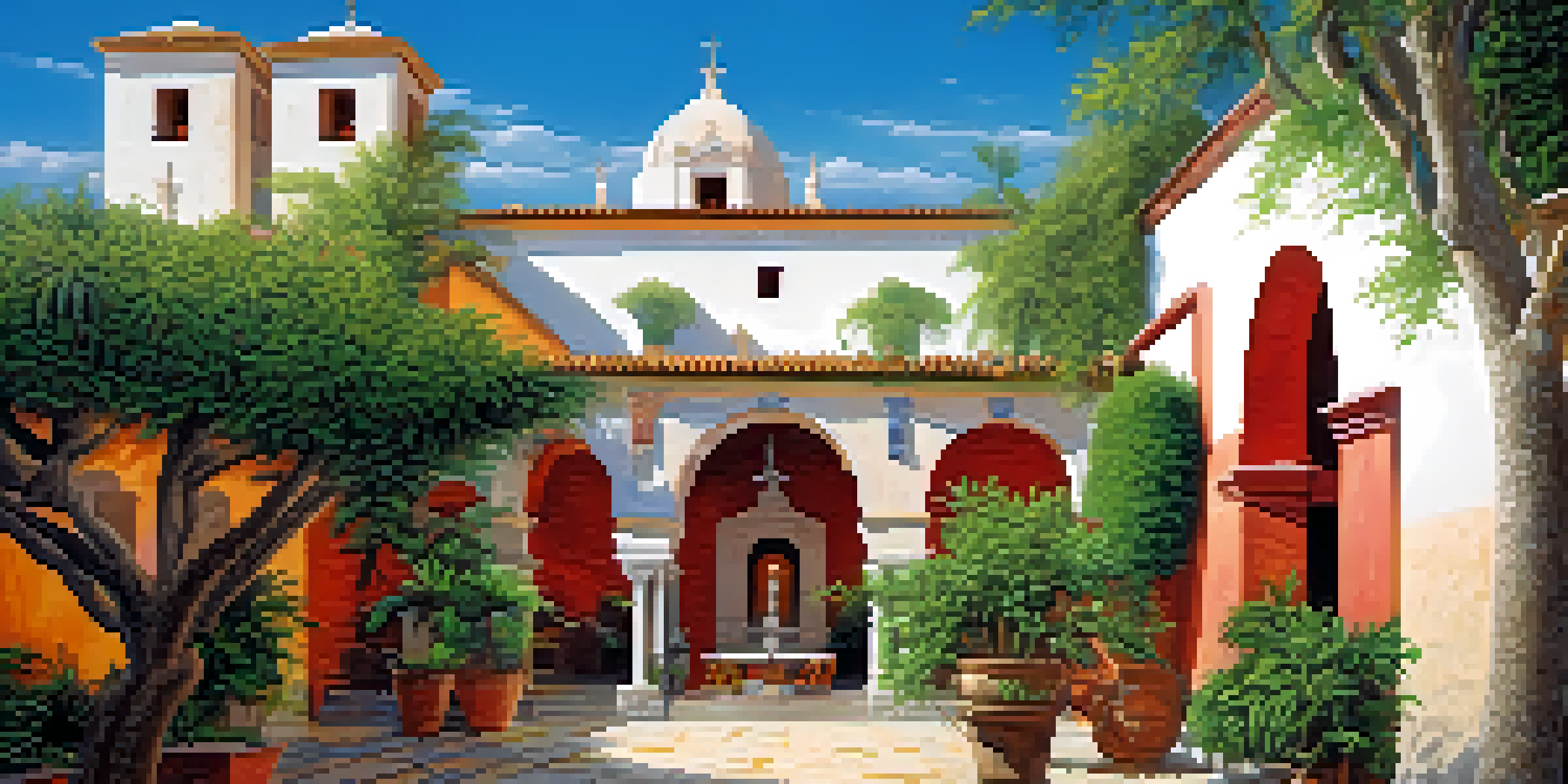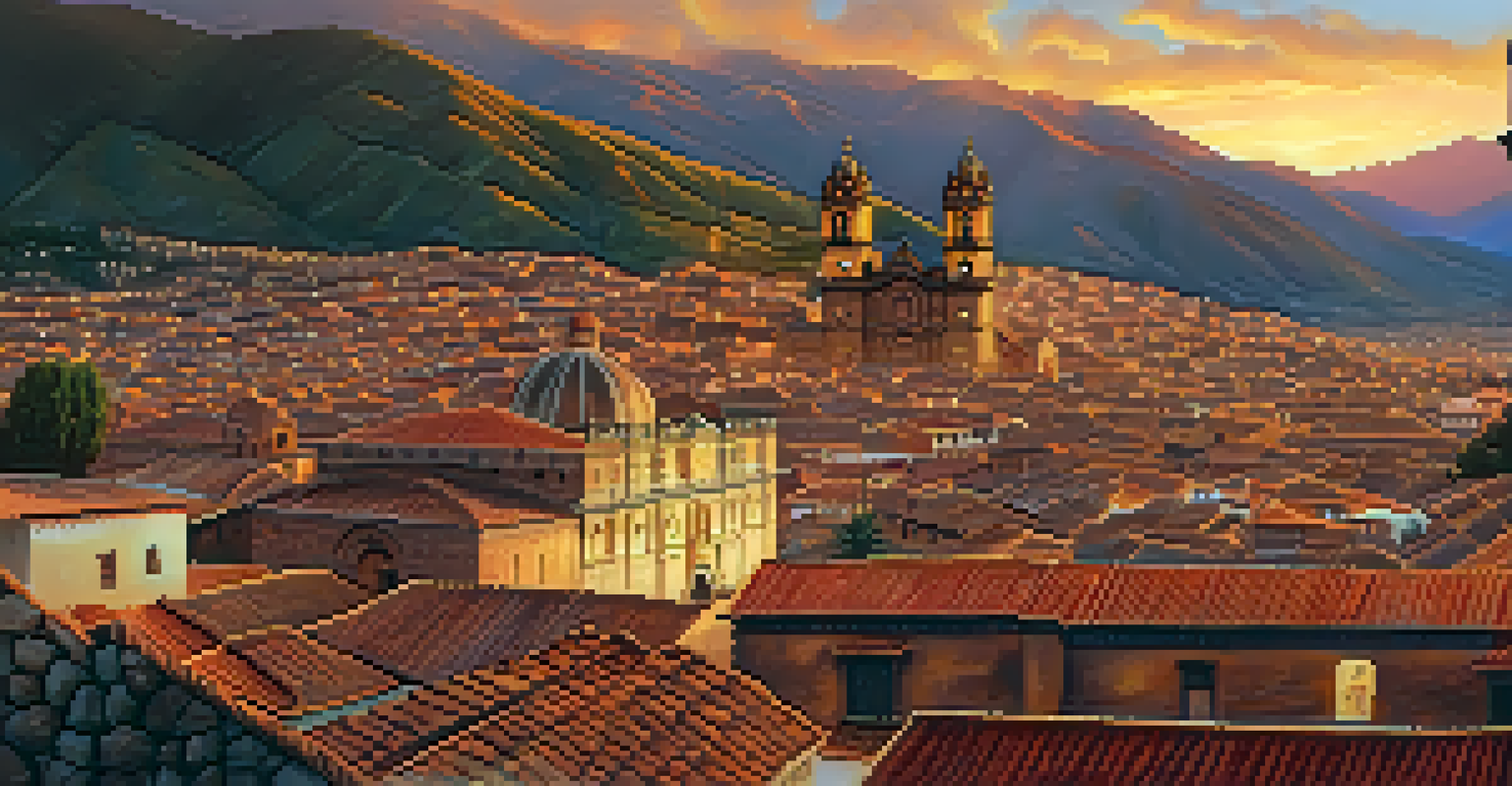Colonial Architecture: The Legacy of Spanish Influence in Peru

Understanding Colonial Architecture in Peru
Colonial architecture in Peru reflects a fascinating blend of indigenous and Spanish styles. This unique fusion emerged during the Spanish conquest in the 16th century, which introduced European architectural principles to the region. The result is a distinct aesthetic that showcases the cultural melding of two worlds, evident in many historical structures throughout the country.
Architecture is the learned game, correct and magnificent, of forms assembled in the light.
One of the most notable features of this architecture is the use of local materials, such as adobe and stone, which were combined with European design elements. These buildings often feature baroque facades, intricate ironwork, and magnificent wooden balconies that catch the eye. This blend not only highlights the creativity of Peruvian artisans but also their adaptability to new influences.
Today, colonial architecture serves as a vital link to Peru's past, offering insight into the lives and experiences of those who lived during the colonial period. It’s a celebration of resilience and artistry that continues to inspire modern architecture in the country.
Key Characteristics of Spanish Colonial Architecture
Spanish colonial architecture is marked by several defining characteristics, including thick walls, arched doorways, and tiled roofs. These elements were practical, providing insulation against the heat and protecting against the heavy rains common in certain regions. The use of courtyards is also prevalent, creating a private oasis that fosters community and family ties.

Another hallmark of this style is the integration of religious symbolism, prominently featured in churches and public buildings. Many colonial churches, such as the Cathedral of Lima, showcase intricate altarpieces and ornate decoration that reflect the importance of Catholicism in daily life. These structures not only served as places of worship but also as centers of social activity.
Colonial Architecture's Unique Blend
Colonial architecture in Peru showcases a captivating fusion of indigenous and Spanish styles, reflecting the rich cultural history of the region.
Colorful frescoes and murals often adorn the interiors, telling stories of faith and local culture. This rich visual language not only beautifies the spaces but also acts as a historical narrative that connects current generations to their heritage.
Prominent Examples of Colonial Architecture in Peru
One of the standout examples of Spanish colonial architecture is the historic city of Cusco, once the capital of the Inca Empire. Here, you'll find a remarkable mix of Incan stonework and Spanish baroque architecture, particularly in structures like the Coricancha temple, which was transformed into a church. This juxtaposition tells a powerful story of conquest and adaptation.
The past is not dead; it is not even past.
Another significant site is the city of Arequipa, known for its stunning white sillar stone buildings. The Santa Catalina Monastery is a prime example of colonial architecture, with its vibrant colors and expansive layout creating a serene environment. The monastery is not only an architectural gem but also a glimpse into the lives of the nuns who once resided there.
Lima, the capital, boasts numerous colonial buildings, including the Government Palace and the Basilica Cathedral. These sites are integral to understanding Peru's historical narrative, showcasing the grandeur and influence of Spanish architecture in urban settings.
Cultural Significance of Colonial Architecture
Colonial architecture represents more than just buildings; it embodies the complex history and cultural identity of Peru. It serves as a reminder of the country’s colonial past, reflecting the struggles and triumphs of its people. Each structure has a story to tell, connecting the present to the past in a tangible way.
Moreover, these architectural masterpieces are essential to Peru’s tourism industry, drawing visitors from around the world eager to experience the rich history. Walking through the streets lined with colonial buildings provides a sense of nostalgia and appreciation for the craftsmanship that has stood the test of time.
Challenges in Preservation Efforts
Urbanization, environmental factors, and limited funding pose significant challenges to preserving Peru's colonial architectural heritage.
However, the preservation of these sites is crucial. Efforts to maintain and restore colonial architecture not only protect these historical treasures but also promote cultural pride among Peruvians. It’s a celebration of their heritage that fosters a deeper understanding of their national identity.
Challenges in Preserving Colonial Architecture
Despite the beauty and significance of colonial architecture, it faces several preservation challenges. Urbanization and modern development often threaten these historic sites, as new construction encroaches upon them. This rapid change can lead to the neglect or even destruction of valuable cultural landmarks.
Additionally, environmental factors such as earthquakes and climate change pose a significant threat. Peru is located in a seismically active region, making many colonial buildings vulnerable to damage. Preservation efforts must incorporate strategies to safeguard these structures against natural disasters while maintaining their historical integrity.
Funding for restoration projects can also be a hurdle. While there are various organizations dedicated to heritage preservation, financial resources can be limited. Raising awareness about the importance of these sites is essential in garnering support from both local communities and international bodies.
Modern Interpretations of Colonial Architecture
Today, architects and designers are inspired by colonial architecture, incorporating its elements into contemporary designs. This modern interpretation maintains the essence of traditional styles while embracing innovation and sustainability. Buildings that pay homage to colonial aesthetics can be seen in urban developments, blending the old with the new.
For example, the use of open courtyards and natural materials in modern homes reflects the influence of colonial design principles. By integrating these features, contemporary architecture can create spaces that foster community, much like the colonial structures did centuries ago.
Modern Interpretations and Future
Contemporary designers are inspired by colonial architecture, creating modern spaces that honor traditional aesthetics while promoting sustainability.
This revival of interest in colonial styles not only preserves the legacy of the past but also enriches the architectural landscape of Peru. It encourages a dialogue between history and modernity, allowing new generations to appreciate and learn from their cultural heritage.
The Future of Colonial Architecture in Peru
As we look to the future, the importance of preserving and honoring colonial architecture in Peru cannot be overstated. Educational initiatives aimed at raising awareness among younger generations about their architectural heritage are vital. By fostering a sense of pride and responsibility, future custodians of these structures can emerge.
Moreover, collaboration between government, local communities, and heritage organizations is essential for effective preservation efforts. This partnership can lead to innovative solutions that balance development with conservation, ensuring that these historical treasures are safeguarded for years to come.

Ultimately, colonial architecture is a testament to Peru's rich and diverse history. By valuing and preserving these structures, we not only honor the past but also lay the groundwork for a more culturally aware and connected future.